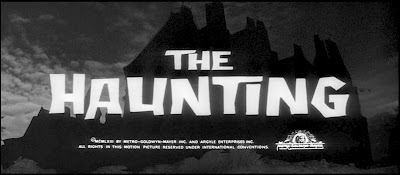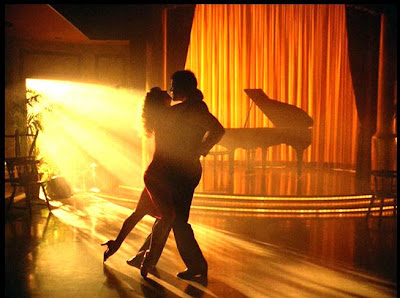"The dead are not quiet in Hill House."
As a child, I tried watching The Haunting one evening when it aired on network television, but I
don’t think I lasted more than 20 minutes…if that. Then more accustomed to the
get-right-down-to-business directness of Creature
Features–style horror movies, The
Haunting’s deliberate pacing and leisurely approach to character and mood
severely taxed my ten-year-old attention span.
It wasn’t until a 1999 screening of The Haunting on TCM (to coincide with the theatrical release of
the atrocious mega-budget, CGI-laden remake) that I opted to give the film
another look. Well, the passing years must have worked its alchemy on either the
movie or me, for this time out The Haunting held me in rapt fascination
in front of the TV set (do they even call them that anymore?), caught up in 112-minutes of the sharpest, most enjoyably tense movie terror I can recall.
What was tedious and meandering to me as a child was
absorbing and spooky as hell as an adult. The characters involved me, the
psychological/paranormal uncertainties intrigued me, and I especially responded
to the inherent risk in making a haunted house film that dares you to take it
seriously. The director respects the genre, the screenplay doesn't insult the intelligence, and the actors don't play down to the material. Best of all: the thrills contained in The Haunting
extend so far beyond its ghostly surprises that a great deal of pleasure is
derived from rewatching the film just to see the interplay of the characters. The
performances are just that interesting, the characterizations just that developed.
When I think of how often it is I find myself, as an adult,
at the polar-opposite end of an aesthetic bias I held in my youth, when I'm made aware to what degree my early tastes were shaped by my limited life experience; I can’t
help but wonder if American cinema hasn't harmed itself in always so doggedly courting the youth market (The
Avengers, The Hunger Games).
Movies today are bigger, louder, and faster to be sure (e.g., the aforementioned The Haunting remake), but how good can
they be if the whole of the criteria to which they hold themselves are the
ADD standards of the texting/tweeting generation?
 |
| Julie Harris as Eleanor Lance |
 |
| Claire Bloom as Theodora |
 |
| Richard Johnson as Dr. John Markway |
 |
| Russ Tamblyn as Luke Sanderson |
 |
| Lois Maxwell (Bond's Miss Moneypenny) as Mrs. Markway |
Dr. John Markway (Richard Johnson), eager-beaver
anthropologist and self-styled supernatural sleuth, invites several
“assistants” to participate in an investigation of paranormal activity in what is
believed to be an actual haunted house. Of the several invited to join (culled
from a list of subjects “…touched in some way by the supernatural”) only two
show up: stylish ESP whiz, Theodora —“Theodora…just Theodora” — (Claire Bloom),
and the emotionally fragile spinster Eleanor Lance (Julie Harris). On hand as
a kind of drowsy chaperone to the proceedings is Luke Sanderson (Russ Tamblyn),
born skeptic and nephew to the owner of Hill House. What follows is as much an incisive
character study or psychological thriller as ghost story.
 |
| Cast of The Haunting |
Somewhere on the path toward chasing the easy dollar,
directors of horror films seem to have forgotten that horror is not exactly
synonymous with gore. The sense of dread and equilibrium-rattling unease at the core
of every great thriller comes from an understanding of that unique quirk of the
human mind that makes it possible for a person to scare the hell out of
themselves with just the slightest assist from outside stimuli.
The Haunting is
famous (and rightly so) for being one of the finest screen examples of
nail-biting terror with nary a drop of blood or ANYTHING being shown. I’ve never
seen the 1961 film The Innocents
(recommended by a reader of this blog, it’s at last on my DVR queue…thank you
TCM!) but I understand that it succeeds in much the same way. Through the
employment of moodily atmospheric lighting, evocative music, crazily subjective
camera angles, and top-grade performances from its impressive cast The Haunting builds and sustains such a
high level of wariness and suspense that it fairly gets under your (crawling)
skin before you realize it.
 |
| The Haunting is a great deal of scary fun |
How The Haunting
achieves this is rather uncanny, for I’m sure the experience is different for
each viewer. In my case, returning to the film after so many years, during which
time I’d been exposed to such seminal horror masterpieces as The Exorcist, Alien, The Shining,
et.al., I had essentially cast myself in the know-it-all skeptic role that West Side Story’s Russ Tamblyn handles
so well. I honestly didn’t think a 35-year-old horror film could pack much
punch, and I was only motivated to try The Haunting again because I was
so excited about the remake (mostly because of Lili Taylor. Alas, that film
found a way of squandering even her talent).
But what took me by surprise in seeing The Haunting again after so long is how it never felt in the least
bit dated, and how the overall intelligent approach to the material struck me
as almost startlingly atypical for the genre. It reminded me of what I love in Polanski thrillers
and typifies the best in the films of Val Lewton (Cat People, The Seventh
Victim).
 |
| "There won't be anyone around if you need help. We couldn't hear you...in the night. No one could...in the dark...." Terrifically ghoulish housekeeper, Mrs. Dudley (Rosalie Crutchley) |
WHAT I LOVE ABOUT
THIS FILM
A director with a little imagination can bring quite a lot
to a genre film if he/she is willing to have fun with its conventions. Horror
films are notoriously plot-driven, moving its characters about like game
pieces, all in service of coincidence-heavy story machinations. Although a standard ghost story in many ways, The Haunting nevertheless feels like a different
breed of animal entirely, due to the degree of depth with which it depicts its characters. The film invites us to contemplate the possible connection between the escalating
intensity of a supernatural “haunting” and the gradual disintegration of a character’s psychological
state. In doing so, it’s remarkable to discover how chilling a simply constructed, bloodless horror film can be when time is invested in getting the audience to be receptive to the vulnerable humanity of its protagonists.
 |
| It's not difficult to take note of parallels to Stephen King's Carrie when we learn about Eleanor's back story (repressed youth, social outcast, an unexplained hail of stones raining on the family house for several days, possible unacknowledged psychic ability). She even has a sister named Carrie!, |
PERFORMANCES
I haven’t seen a great deal of Julie Harris’ work, but from
the looks of it she was the go-to-gal for repressed, emotionally delicate
types. It’s certainly easy to understand why, and by no means is pointing that out
a diminution of her talent. In fact, she is to be commended on her consistent ability
to add dimension to roles that must appear on paper to be of a rather limited
emotional palate. As Eleanor, she is, dramatically speaking, the very center of
The Haunting and it’s through her touching
and enigmatic performance (Is she mad? Possessed?) that the film draws us in.
On repeat viewings it becomes more apparent what a complex character Harris
creates in Eleanor. A sad, lonely woman of bottled-up, barely understood
emotions, Eleanor can be by turns charming, determined, dreamy, and petulant;
all adding up to the kind of realistic characterization necessary to add
verisimilitude to The Haunting’s Gothic mayhem.
THE STUFF OF DREAMS
The Haunting is unequivocally
and most emphatically a ghost story, but I like how
the film allows for the ambiguous intermingling of the psychological
and supernatural. Eleanor’s precarious mental state is revealed to us through
the extensive use of first-person voiceover, but this extra-sensory intimacy device
only makes us more unsure about her ability to distinguish between what is real and what is imagined. As
Eleanor’s emotions intensify, there’s the sense that she is perhaps suffering
some kind of mental breakdown; practically willing Hill House to be the beckoning
destiny she simultaneously fears and desires. Other times, Hill House (always spoken
of in terms usually reserved for a living thing) feels as though it is feeding upon
and growing stronger from the fears and weaknesses of its inhabitants.
In balancing these complimentary/conflicting realities, The Haunting arrives at a narrative
structure which mirrors the discordant perspectives of its characters—the realists:
Luke & Mrs. Markway; the psychics: Eleanor& Theodora; and the scientist:
Dr. Markway.
Small wonder that The Haunting's reputation as one of the most effective horror films ever made continues to grow with each passing year. Each time I watch it I discover something new. And sometimes, if I really allow myself to get swept up in the ghost story, I can still find myself experiencing the odd goosebump chill as that massive old house goes into its act.
BONUS MATERIAL
For more information and trivia about the making of The Haunting, be sure to check out this wonderfully comprehensive website: The-Haunting.com
Copyright © Ken Anderson


















.JPG)































